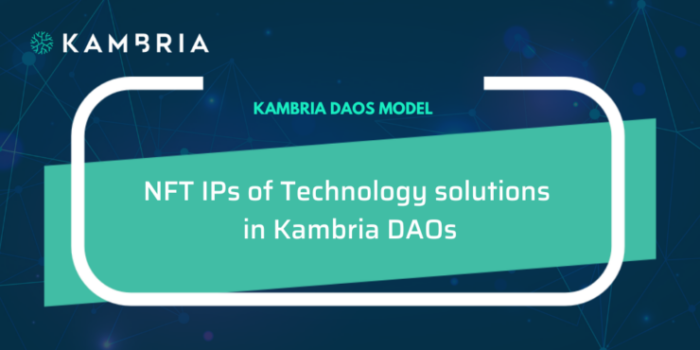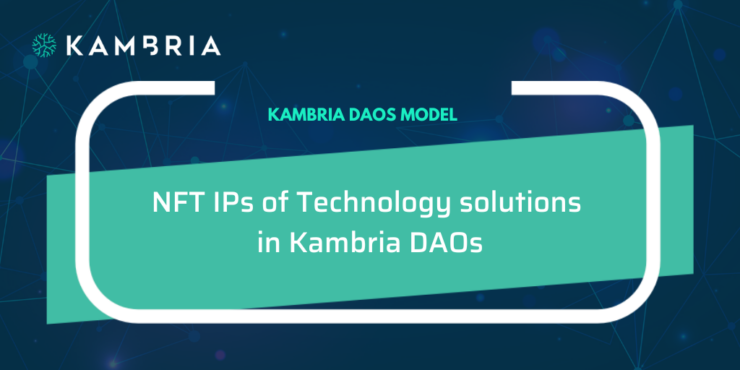
As you may already know, Kambria DAOs is a way for the community to co-own technology, with the approach to open source the technology solution for the members of the DAO.
As introduced in the governance model of Kambria DAOs, Dev Teams will submit their work to the DAOs including source codes, demos, documents, and presentations; and the submissions will be packaged and tokenized as DAO IP NFTs. By this we can enable open-source solutions to be commercialized by the DAO community.
In this article, we would like to share in more detail about NFT IPs of Technology solutions in Kambria DAOs.
The DAO development work will be tokenized in NFTs
As you may already know, non-fungible tokens, or NFTs, are blockchain-based cryptographic assets with unique identification codes and metadata that differentiate them from one another.
NFTs provide a powerful tool to protect the DAO IPs by establishing ownership, attribution, and royalty mechanisms on the blockchain. They enable a more secure, transparent, and decentralized framework for managing and monetizing IP assets.
NFTs help IP trade more effectively by making IPs more cost-effective to license, compared to the traditional IP registration process which requires a lot of time, paperwork and complicated legal requirements.
So for the technology solutions of Kambria DAOs, each license will be represented by an NFT, and the licensing of DAO solutions is applied in the context of franchising after development phase:
- Dev Partner will become Production Partner at their local.
- The DAO will scale to other locals by franchise model, in which a manufacturer at a local buys a technology solution license to become Production Partner of the DAO. The license pricing would be $15.000.
- Dev Partner owns 1 license and will get $5.000 revenue sharing on each license sale to other Production Partners. Dev Partner will handle the technology transfer in the franchising.
Some benefits that Production Partners can derive from their association with the DAO:
|
Kambria DAO IP NFT Description
This part is a detailed description of the DAO IP NFT.
Overview
- A technology solution version includes an intro deck, demo videos, source codes and technical documents.
With the approach to open source the technology solution for the members of the DAO:
|
- Allows minting multiple NFTs for 1 IP corresponding to the number of licenses granted to Production Partners.
- In the context of intellectual property, it is important to note that licensees are prohibited from reselling or gifting the NFTs they possess. Engaging in such activities would result in the buyer's Production Partner rights not being properly recognized, and it would also lead to the seller losing their Production Partner rights.
Metadata
- With contents in Google Drive, the metadata stored in the NFT includes:
- Google Drive file URL.
- Google Drive file ID obtained from the URL of the Google Drive file.
- Metadata timestamp when the metadata was created or associated with the NFT. This helps establish the timeline and ensures that the association with the Google Drive content is clear.
- Additional information: title and description.
- With contents on Youtube, the metadata stored in the NFT includes:
- YouTube video URL.
- YouTube video ID typically found in the URL of the YouTube video.
- Metadata timestamp when the metadata was created or associated with the NFT.
- Additional information: title and description.
Implementation
So in the development phase, Dev Teams will submit their work on Kambria platform.
- The submission will then be listed in the Codebase on Kambria platform, tokenized to NFTs using NFTify to sent to the DAO (because NFT creation requires a personal sign which the DAO does not have, DAO cannot create NFTs itself).
- For license purchase transactions, we will develop the DAO NFT IP License Sale smart contract to automate the transactions of license purchase and revenue sharing for DAO members and Dev Partner.
From Kambria NFT IP Program to NFT IPs of technology solutions in Kambria DAOs, we are coming closer to a feasible model of IP management in the open innovation age.
Sincerely yours,
Kambria.








